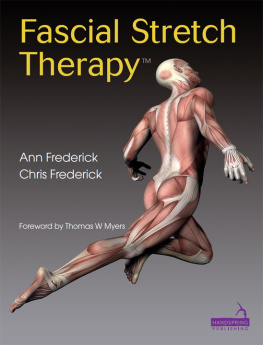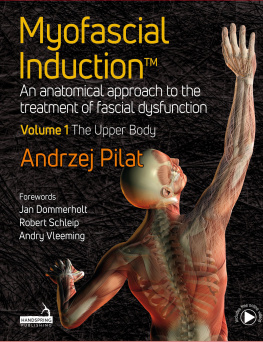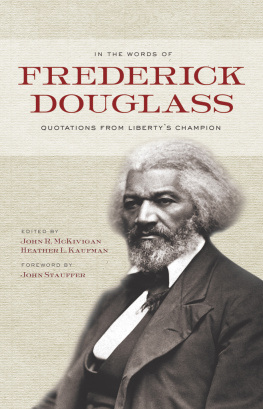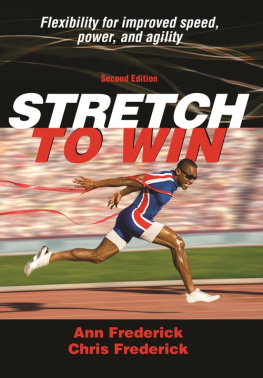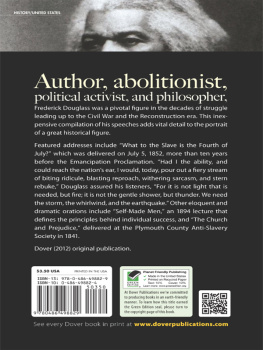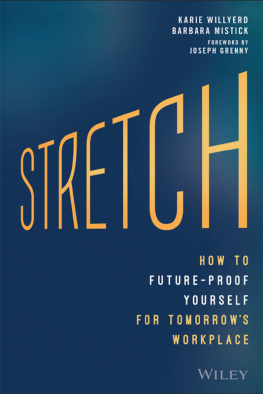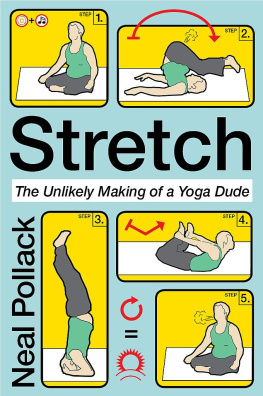Fascial Stretch Therapy

HANDSPRING PUBLISHING LIMITED
The Old Manse, Fountainhall,
Pencaitland, East Lothian
EH34 5EY, United Kingdom
Tel: +44 1875 341 859
Website: www.handspringpublishing.com
First published 2014 in the United Kingdom by Handspring Publishing
Copyright Handspring Publishing Limited 2014
Copyright Photographs Ann and Chris Frederick 2014
All rights reserved. No parts of this publication may be reproduced or transmitted in any form or by any means, electronic or mechanical, including photocopying, recording, or any information storage and retrieval system, without either the prior written permission of the authors and publisher or a license permitting restricted copying in the United Kingdom issued by the Copyright Licensing Agency Ltd, Saffron House, 6-10 Kirby Street, London EC1N 8TS.
The right of the Authors to be identified as the Author of this text has been asserted in accordance with the Copyright, Designs and Patents Acts 1988.
IISBN 978-1-909141-08-7
eISBN 978-1-909141-43-8
British Library Cataloguing in Publication Data
A catalogue record for this book is available from the British Library
Important notice
It is the responsibility of the clinician/practitioner, employing a range of sources of information, their personal experience, and their understanding of the particular needs of the patient/client, to determine the best approach to treatment.
Neither the publishers nor the authors will be liable for any loss or damage of any nature occasioned to or suffered by any person or property in regard to product liability, negligence or otherwise, or through acting or refraining from acting as a result of adherence to the material contained in this book.
Commissioning Editor Sarena Wolfaard
Design and Illustrations by Bruce Hogarth, kinesis-creative.com
Indexer: Dr Laurence Errington
Typeset by DiTech Process Solutions
Printed in the Czech Republic by Finidr Ltd
The
Publishers
policy is to use
paper manufactured
from sustainable forests

Guide
Key to Chapter 2 Icons
 | Synchronize your breath with your movement |
 | Tune your nervous system to current conditions |
 | Follow a logical order |
 | Achieve ROM gains without pain |
 | Stretch your fascia, not just your muscle |
 | Use multiple planes of movement |
 | Target the entire joint |
 | Get maximal lengthening with traction |
 | Facilitate body reflexes for optimal results |
 | Adjust stretching to present goals |
T his book is the product of two individual journeys, meeting up and collaborating.
Anns story
When I was a young girl, I had a premonition that I was destined to create something that would unite art and science. I was unsure what it would be or when it would happen, but I knew it was my calling. I also knew it would change the way people looked at the topic and that it would eventually spread worldwide. When it occurred, the development of FST felt like a combination of divine guidance and pure necessity.
FST has been a blessing beyond words. People may question why I would want to teach a technique I had developed and lose the exclusivity of being the only person to offer it. My response has always been that when we are given a gift it is our responsibility to give back. How could I not share something that has brought so much joy and hope to myself and so many others?
From age of four until I was 40, I spent my life in a dance studio. I was both dancing professionally and teaching from the young age of 14. Movement and the wonder of the body have been a part of my daily life for a very long time. My other passion was the science of the human body. I took every course offered on the subject in school and read as much as I could about it. In high school, I distinctly remember going home and learning all 206 bones in one evening.
I spent many years training dancers in flexibility and not one was ever injured on my watch. I attributed it to the focus in my classes on extensive flexibility training to which I dedicated at least 30 minutes during the warm-up component in each class. In the dance world, extreme flexibility along with strength is a non-negotiable requirement.
While teaching a group stretch class at a local gym, I had an epiphany. I looked out over my class, which was filled to capacity, and realized that there was a great need in people to become more flexible, indeed senior citizens made a big chunk of the class. This new awareness of the general population needing and, more importantly, wanting help with their flexibility was eye opening and very exciting. My vision was becoming clearer once I enrolled at Arizona State University (ASU), getting my degree and studying academic dance with a focus in kinesiology.
As life would have it, at the end of one of my first stretch classes, a guy came up to me and said, They need what you are doing here at the ASU athletic department.
It was an opportunity to work with college athletes from 26 different sports.
The journey of creating Fascial Stretch Therapy began in the summer of 1995 in the weight training room at ASU. It occurred on the bench press when I tied a weight belt around a football players leg to hold it still while I stretched him. I realized that if I could get proper leverage on this big guy by getting him up off the floor and using a stabilizing strap, I was truly on to something. And the rest, as they say, is history. Each time I had someone on the treatment table in my private practice, I developed the new method a bit more. Between my studies and my private practice I was working upwards of 18 hours a day. I was on the football field in the morning taking the team through group stretches or in the weight room working with individual athletes. I worked for several hours before class and then again after class each afternoon. I would then go to my office and spend time honing the art of my newfound career. It was not unusual for me to spend ten hours a day stretching individual clients.

